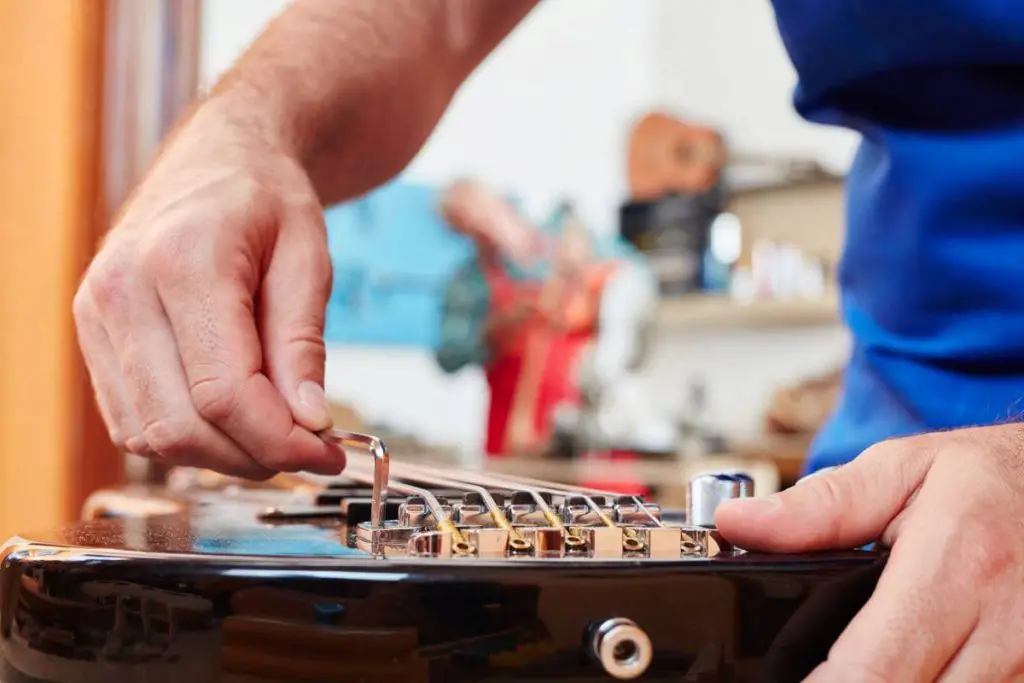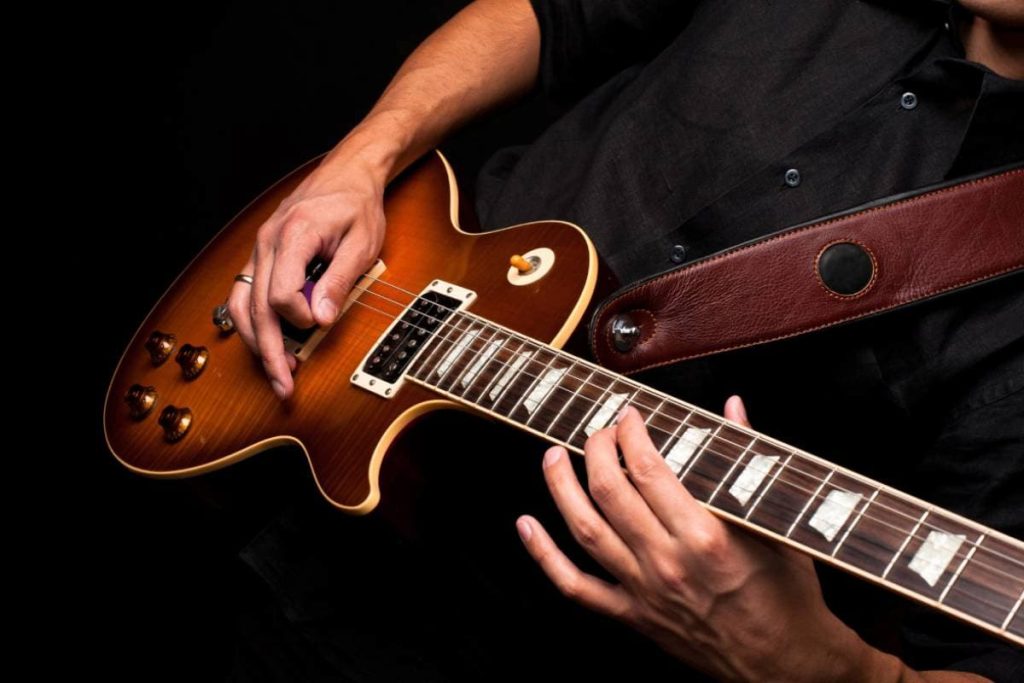When choosing a new guitar, establishing its quality beforehand can be of the essence. Most guitars share a wide range of similar features; however, there are a few tell-tale signs that can help differentiate between an instrument that’s worth the investment and one that isn’t. Here’s what you’ll want to be looking out for when buying a new guitar:
Here are a few simple ways to know if a guitar is good.
- Conduct a visual inspection for damage.
- Check the guitar for low action.
- Confirm the guitar’s pitch accuracy and intonation.
- Ensure the tuning knobs work well.
- Inspect the guitar’s neck.
- Check the soundboard for cracks.
- Inspect the guitar body for loose parts and cracks.
- Test the guitar’s electronics.
- Evaluate the materials.
- Assess the sound quality.
- Ensure the guitar is comfortable to play.
This article will explore some of the simplest ways to determine if the guitar you own or you are about to purchase is in good condition. So, read on to learn more.
👇😀👇NOTE👇😀👇
If you want to find out what my recommended guitar gear is, then here is what I recommend on Amazon:
- Fender Cutaway Acoustic-Electric Guitar Bundle (MY FAVORITE GUITAR)
- Snark SN-8 Super Tight All Instrument Tuner (Easiest Tuner I’ve Used😏)
- 6 String Acoustic Guitar Capo (Best CAPO for quick changes)
- Dunlop Max Grip 1.0mm Nylon Picks (Thick Guitar Pick So You Don’t Lose Grip!)
- Universal Guitar Stand (Cheap & Minimalist Guitar Stand I Recommend)
- Levy’s 2″ Wide Quick Adjust Guitar Strap (Best Guitar Strap For Any Level)

1. Conduct a Visual Inspection for Damage
It may seem like you have a lot to consider before choosing the right guitar. You should not let this overwhelm you because the factors you should consider are pretty straightforward.
The first simple and obvious way to determine if a guitar is of good quality is by conducting a visual inspection for damage. A simple visual inspection can help you isolate any glaring issues early on before checking the guitar’s components for specific problems.
Watch out for obvious problems such as broken or missing strings and tuning pegs during the visual inspection.
Finally, use the opportunity to determine the guitar’s aesthetic appeal and style. The guitar’s look and style are more important than most guitarists imagine or are willing to admit. For instance, guitars that lack position markers along the fretboard are relatively more difficult for some guitar players, particularly the novices.
You get immersed and lost in the feeling more when you enjoy the look and style of the musical instrument you use to express yourself. Therefore, don’t overlook the guitar’s look and style during your visual inspection, even if it has no visible damage.
2. Check the Guitar for Low Action
Another simple way to check if a guitar is good is to confirm if it has low action. Action in guitar terminology refers to the strings’ height from the fretboard. Usually, the greater the height and space between the fretboard and strings, the tighter the guitar strings are. This makes it difficult to press down on the strings when playing the guitar, slowing and ruining the playing experience.
Additionally, greater action gives the guitar strings more tension, causing them to inflict pain and sores on your fingertips after prolonged playing periods. This will inevitably affect your playing progression as you can only practice effectively for limited periods.
You should measure the strings’ height from the fretboard at different points along the guitar’s neck to determine how much action the guitar has. Your guitar should have low action measured at 5/64”. If the measurement turns out higher than that, the guitar has high action, indicating a bad guitar.
The guitar’s action does not have to be a deal-breaker because you can adjust it. The adjustments usually depend on the type of guitar at your disposal. However, the easiest method of fixing the action entails raising or lowering the bridge if it has individual string saddles.
Turn a screw clockwise to raise the bridge and anticlockwise to lower it. Remember to keep the same height on both sides of the saddle.
If the action is off due to a floating tremolo bridge, you can only adjust the string saddles after adjusting the bridge tension, and if it’s too high at the nut, your only option is to file the component.
Take note that this cannot be undone. Therefore, don’t embark on a DIY fix if you’re unsure about how to proceed. Generally speaking, it’s always a good idea to hire a professional technician or purchase a new guitar with no issues regarding its action.
I recommend using an allen wrench to turn the screws safely when it comes to guitar action adjustment. Consider using the Nobrand IVU Creator Allen Wrench (available on Amazon.com). It’s a handy tool for guitarists that you can carry on the go inside your gig bag.

3. Confirm the Guitar’s Pitch Accuracy and Intonation
The next simple way to know if a guitar is good or not is by checking its pitch accuracy and intonation. Usually, guitars need to be well-tuned before you can play sensible melodies. Each string needs to be adjusted to a specific pitch for the guitar to be tuned perfectly.
So, how do you check if the guitar has the proper intonation?
The easiest way is to use a guitar tuner application. Multiple applications exist that listen to the pitch of the string you play and offer feedback on the level of correction you need to make.
If you don’t have a guitar tuner application or another reference point, play a harmonic on the 12th fret, then play a note on the same fret the usual way. The guitar is well-tuned if the pitches match. However, the note is higher or flatter than the harmonic, the guitar is off and needs adjustment.
4. Ensure the Tuning Knobs Work Well
Another simple way to know if a guitar is good is by testing the tuning knobs. You must always ensure the guitar’s tuning knobs work correctly, given their crucial function. The tuning knobs enable you to correct the pitch on the guitar strings whenever you need to.
Turn each tuning knob at least one full rotation up and down and ensure they turn easily without resistance. The tuning knobs should also move each gear when turning without snapping the guitar strings.
If you notice that the tuning knob turns loosely without tightening or loosening the strings, they are faulty and need replacing.
Fortunately, they are relatively cheap and easy to replace. Therefore, faulty tuning knobs don’t necessarily make a guitar bad, provided you are ready to replace them.

Should you choose to replace the faulty tuning pegs, I recommend purchasing SAPHUE 6R Guitar Tuner Pegs (available on Amazon.com). They are universal size machine head tuners fitting almost all acoustic and electric guitars. They are also made from a metal alloy, which is solid and durable.
5. Inspect the Guitar’s Neck
Another simple way to know if a guitar is good is by inspecting its neck. The guitar neck should be straight on both sides from the headstock to the bridge with little to no twisting and warping.
A warped guitar neck is a significant concern because it affects playability and your capacity to tune the guitar to the correct pitch. The phenomenon involves the two sides of a guitar’s neck being asymmetrical. You want to avoid any guitar that has a warped or twisted neck.
However, don’t confuse the curvature from the truss rod with that of the neck. The truss rod is a guitar component made from a steel bar or rod positioned below the fingerboard to support and stabilize the guitar neck’s forward curvature. While some guitars have non-adjustable truss rods, most feature adjustable ones enabling you to correct excessive twisting of the guitar neck.
Therefore, seek clarification from the seller if you notice a warped guitar neck to determine whether or not it is adjustable. If it’s not, the guitar is faulty and likely to cause you more problems along the way.
However, if it’s with the truss rod, ask a professional at the shop for assistance when it comes to fixing it.
After establishing that the guitar neck is intact and in good condition, it’s time to move to the fretboard and ensure it is flat, smooth, and dent-free. Run your palm along the fretboard’s side and confirm if any protruding frets are present.
Protruding frets are also not a significant deal-breaker because you can grind down or replace the fret and have the guitar functioning properly again. However, factor in the time and money required to repair the fretboard before purchasing a faulty guitar.
6. Check the Soundboard for Cracks
Next, check the guitar soundboard for any visible cracks. The soundboard can develop cracks in several ways. For example, frequent falls of the guitar are likely to cause the soundboard to weaken and develop cracks at some points.
Another factor causing the soundboard to develop cracks is temperature changes in the surrounding environment. Guitars are made from a wooden material that expands and contracts with the fluctuation of the surrounding temperature. Repeated contraction and expansion lead to the development of cracks on the soundboard, affecting the guitar’s sound quality and amplification.
Ensure the soundboard doesn’t have cracks if you’re looking to buy a good-quality guitar. The soundboard cannot perform its critical function in the guitar’s projection and amplification quality or determine the tone if it has cracks.
Fortunately, if an existing guitar is suffering from this issue, you can repair the cracks and restore its quality. However, some cracks may be too deep to repair or too large for invisible repairs. So, while you may repair the crack, you’ll still spoil the guitar’s aesthetic appeal. You should consider these factors before deciding whether or not a guitar with a cracked soundboard is good enough to invest in.

7. Inspect the Guitar Body for Loose Parts and Cracks
It’s equally important that the rest of the guitar has no cracks for functional and aesthetic purposes. Therefore, the next simple way to determine if a guitar is good is by inspecting its body for loose parts and cracks.
Focus on the seams during this inspection because loose or separated seams are the most common problem here. When the seams are loose, the pieces of wood will separate at various points to make the guitar detach, especially at the joints where the bridge and soundboard, headstock and neck, and neck and body are glued together.
After you’ve confirmed that the guitar’s body has no cracks or loose seams, the next step is to inspect the inside of the guitar for loose parts. However, you can’t see inside the guitar. So, how do you check the inside for loose parts?
To confirm whether or not components inside the guitar (e.g., the braces) are loose, tap the guitar all around while listening for rattling or buzzing sounds. If you hear these sounds, the guitar has loose braces that need repairs at an additional cost.
8. Test the Guitar’s Electronics
Next, plug in the guitar to test if its electronics work correctly. Electric and acoustic guitars with inbuilt pickups have electronic components that must be in good condition for the guitar to produce high-quality sound.
Plug in the guitar and tinker with the various components while playing chords to confirm if they are functional. Don’t mind what you play at this stage because the primary objective is to verify that the electronics work fine.
After plugging in the guitar, adjust the volume knob to the maximum and minimum while playing the guitar to confirm that it’s responsive. The amplification and volume should fluctuate depending on how you turn the knob. Repeat a similar procedure with the tone knob, onboard tuners, gain knobs, and EQ sliders to ensure they work well to produce a good-quality sound depending on the settings.
You should also listen for loud pops, and volume drops when switching between pickups. If any of the electronic knobs and tuners are unresponsive, consider getting another guitar as your current one might be faulty.
Use this simple approach to effectively assess all types of guitars, both acoustic or electric.

9. Evaluate the Materials
Another simple way to determine if a guitar is good is by evaluating the materials used to make it. Evaluating the materials used on a guitar entails assessing the pickups and electronics, hardware, as well as the wood used.
Guitars made from rarer wood and better hardware are typically more reliable and durable. Therefore, purchasing a guitar made from good materials will save you from future additional repair and replacement costs.
Moreover, guitars are sentimental musical instruments whose value appreciates as time passes. Vintage guitars possess both sentimental and economic value should you decide to resell. Therefore, assess the quality of the materials and hardware used in the guitar and select one that will last for many years.
Consider these factors closely especially when assessing vintage and second-hand guitars.
10. Assess the Sound Quality
Another simple way to know if your guitar is good is by testing its sound quality. The sound quality is subjective depending on factors such as your preferences, the guitar type, and the type of music you want to play. Therefore, play the instrument to confirm the sound quality suits your preferences before purchasing it.
I recommend playing songs, riffs, and licks you are familiar with rather than new and complicated melodies.
This allows you to focus on the guitar and the sound quality rather than getting the next note right as you play.
Remember, no guitar is good if you don’t love the sound quality, even if it passes all tests previously discussed. Therefore, select an instrument with a sound you enthusiastically love to ensure you enjoy practicing with your newly-acquired guitar.
11. Ensure the Guitar Is Comfortable To Play
Finally, the simplest way to know if a guitar is good is by gauging how it feels. Playing music should ultimately be a fun, enjoyable experience. Therefore, ensure the guitar you select feels comfortable to play.
As many enthusiasts already know, each guitar can feel different when you play it, depending on the type and style. Some guitars feel better when you’re playing them seated, while others feel more comfortable to handle while standing.
Therefore, you must ensure the guitar you choose feels comfortable to play in your preferred position. You should look out for a few factors when testing a new guitar, including its weight and size. If the guitar feels heavy, too large, or small, then it is not ideal for you.
Some guitars may also dig into your ribs because of their size and shape, thus worsening the playing experience.
You shouldn’t overlook these issues, however minor they may seem, because they’ll only get worse the longer time you spend playing.
Make sure the guitar you select has low action that doesn’t injure your fingertips and feels comfortable to play while sitting or standing. The guitar’s neck profile should also match your hand size and shape for maximum comfort as you play music.
You should also remember that most guitars may feel slightly odd at first because they’re different from what you might be used to. The same goes for anyone who has never held a guitar before and is getting acclimated to the new feel.
Ultimately, it’s crucial to separate genuine problems arising from the guitar’s style and design and those resulting from handling a new model.
👇😀👇NOTE👇😀👇
If you want to find out what my recommended guitar gear is, then here is what I recommend on Amazon:
- Fender Cutaway Acoustic-Electric Guitar Bundle (MY FAVORITE GUITAR)
- Snark SN-8 Super Tight All Instrument Tuner (Easiest Tuner I’ve Used😏)
- 6 String Acoustic Guitar Capo (Best CAPO for quick changes)
- Dunlop Max Grip 1.0mm Nylon Picks (Thick Guitar Pick So You Don’t Lose Grip!)
- Universal Guitar Stand (Cheap & Minimalist Guitar Stand I Recommend)
- Levy’s 2″ Wide Quick Adjust Guitar Strap (Best Guitar Strap For Any Level)

